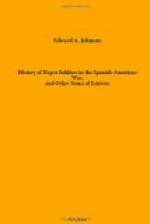[Illustration: MR. BROWN, THE COLORED MAN WHO PACKS AND SEALS THE MONEY OF THE UNITED STATES.]
Brown does his work in a cage at the end of the room in which the completion of the notes is accomplished—the room of the Division of Issues.
The notes are arranged in packages of one hundred before they are brought into the cage. Each package has its paper strap, on which the number and denomination is given in printed characters. Forty are put together in two piles of twenty each and placed an a power press. This press is worked by a lever, something like an old-style cotton press. There are openings above and below through which strings can be slipped after Brown has pulled the lever and compressed the package.
These strings hold the package together while stout manila paper is drawn around it. This paper is folded as though about a pound of tea and sealed with wax. Then a label is pasted on it, showing in plain characters what is within.
The packages are of uniform size and any variation from the standard would be noticed. But a dishonest man in Brown’s position could slip a wad of prepared paper into one of the packages and put the notes into his pocket.
If he did this the crime might not be known for six months or a year, or even longer. Some day there would come from the Treasurer a requisition for a package of notes of a certain denomination. The doctored package would be opened and the shortage would be found. However, the Government has never had to meet this situation.
There have been only two men engaged in packing and sealing currency since the Treasury Department was organized.
John T. Barnes began the work. He was a delegate to the Chicago Convention which nominated Lincoln and he received his appointment on the recommendation of Montgomery Blair in 1861. In 1862 he was assigned to making up the currency packages and fulfilled that duty until his death, in 1894. No mistake was ever discovered in his work, though he handled every cent of currency issued by the government for thirty-two years—so many millions of dollars that it would take a week to figure them up.
Mr. Barnes’ duties were filled temporarily until November 1, when John R. Brown was appointed to the place.
Barnes at the time of his death was receiving only $1,400 a year and Brown draws only $1,200.
Ordinarily the Bureau of Engraving and Printing delivers to the Issue Division about fifty-six packages of paper money of 1,000 sheets each, four notes on a sheet, making, when separated, 224,000 notes. These notes range in value from $1 to $20, and their aggregate is usually about $1,000,000. The government, however, issues currency in denominations of $50, $100, $500, $1,000. The largest are not printed often, because the amount issued is small.
If it could happen that 224,000 notes of $1,000 each were received from the bureau in one day, the aggregate of value in the fifty-six packages would be $224,000,000. As it is, a little more than 10 per cent, of this sum represents the largest amount handled in one day.




